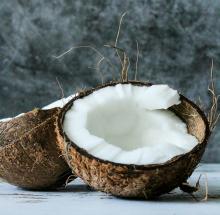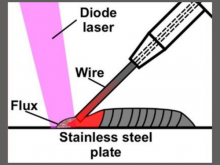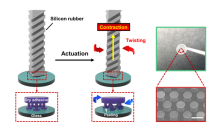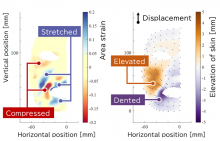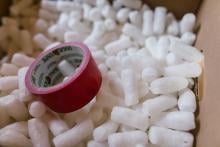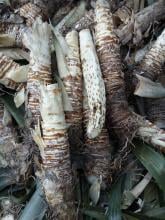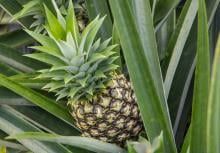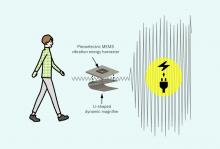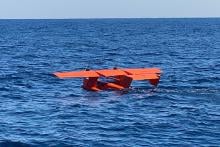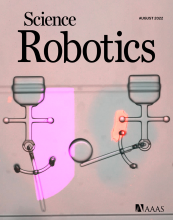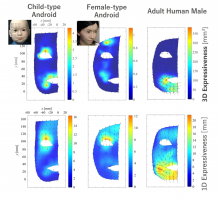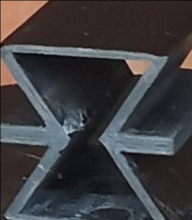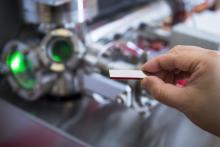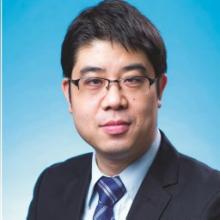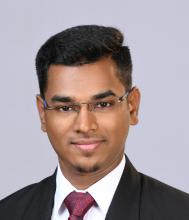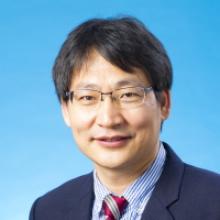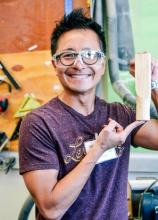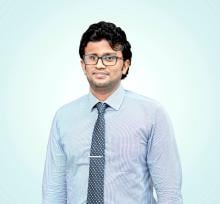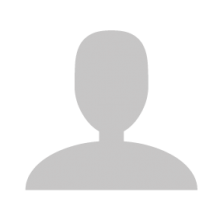Engineering & Technology Mechanical Engineering
News
08 Mar 2024
An international multidisciplinary team of researchers from Singapore, India, Malaysia and Indonesia are breaking boundaries in 3D Printing. They have developed Coir Fiber Polymer Composites with enhanced strength, presenting a new and sustainable way for applications in food and medical packaging.
26 Feb 2024
Magnetic nanorobots delivering nerve cells to targeted tissues could potentially be used to repair damaged brain tissue, as well as other organs.
22 Jan 2024
Researchers from Thailand have pioneered the conversion of waste HDPE milk bottles into high-stiffness composites, utilizing PALF reinforcement for a 162% increase in flexural strength and 204% in modulus. This eco-friendly upcycling boosts mechanical properties while sequestering carbon, presenting a promising path for sustainable materials.
15 Dec 2023
A new study have compared the reinforcing efficiency of pineapple leaf fiber (PALF) and cultivated flax fiber in poly(butylene succinate) composites. PALF, a less explored but potentially sustainable alternative, outperformed flax at 20 wt.%, showcasing its potential in high-performance bio-composites and aligning with environmental goals.
08 Dec 2023
- The team successfully developed an imperceptive surface electromyography (sEMG) sensor that can be stably used in the silicone liner within the socket of a robotic prosthetic leg
- The sensor transmits electromyographic signals wirelessly in a stable manner from a walking amputee to a robotic prosthetic leg for better control
- Research results were published in the prestigious academic journal npj Flexible Electronics
20 Nov 2023
A new technique allows researchers to map how the cellular ‘skeleton’ adapts to external stress.
13 Nov 2023
Steel and aluminum are key players in supporting economic growth, yet materials joining them remain unexplored due to their fusion zones’ brittleness. A new 3D printing method’s fix may be a step toward a steel-aluminum hybrid renaissance.
10 Nov 2023
Researchers develop a technique to allow fragile objects to be transferred and released by robotics, without damage, while using a gecko inspired adhesive.
09 Nov 2023
A research team led by Osaka University used 125 physical markers to understand the detailed mechanics of 44 different human facial motions. The aim was to better understand how to convey emotions with artificial faces. Beyond helping with the design of robots and androids, this research can also benefit computer graphics, facial recognition, and medical diagnoses.
05 Oct 2023
Hunting for supermassive black holes, Coastal survival at risk, Calcium and dead cell clean-up, Two naps are better than one & Pineapple leaf prosthetics. Read all in the latest Editor's Choice.
10 Sep 2023
In this collaborative project between Newcastle University and Universiti Malaysia Perlis (UniMAP), the team aimed to create a sustainable, cost-effective lower limb prosthetic socket (LLPS) using natural fiber-reinforced composites. The objectives included designing a green LLPS, assessing its environmental impact, and engaging stakeholders. Pineapple Leaf Fiber (PALF) was chosen for sustainability. The project has also inspired worldwide interest in sustainable LLPS development through a press release, receiving inquiries from students at Nanyang Technological University in Singapore and a group of 7th graders in the USA.
23 Aug 2023
The search for innovative materials will be greatly assisted by software that can suggest new experimental possibilities and also control the robotic systems that check them out.
23 Aug 2023
Associate Professor Taweechai Amornsakchai and his team of international researchers have developed novel bio-degradable rigid foams derived from pineapple waste, showcasing impressive properties. Starch and cellulosic materials are key components of the foams, which are processed via microwave gel formation and filler blending. The foams feature high strength, and rapid biodegradation, with potential for practical use from packaging, to construction, automotive, and aerospace.
11 Aug 2023
A team of scientists from Thailand and Malaysia, led by principal investigator, Associate Professor Taweechai Amornsakchai from Mahidol University, has successfully developed a low-cost and green method to make films prepared from pineapple stem starch for food packaging, such as fruits and vegetable.
06 Aug 2023
A team of researchers from Newcastle University of Singapore and National University of Singapore, led by Mr Loh Tick Boon, with academic supervisors Dr JJ Chong and Dr Kheng Lim Goh, has developed a novel and practical method of assessing the mechanical properties of structures, with potential application to structural health monitoring of large structures such as bridges and viaducts in Singapore.
06 Aug 2023
A team of researchers from Singapore and the UK, led by Dr Wei Liang Lai, with supervisor, Associate Professor Kheng Lim Goh, has developed a portable device for repairing hard-to-see damage in carbon fiber materials. The device has great potential for the aerospace industry, such as to repair the fuselage of commercial aircraft.
03 Aug 2023
Dr. Zhang Yi, the lead scientist, and his team of researchers from Canada, Singapore, the UK, have successfully completed a study, comparing the efficiency of various bioreactors in producing Raspberry Ketone through Submerged Fermentation. This research marks the first time such a study has been conducted.
22 Jun 2023
An international team of researchers from India and Singapore, led by Associate Professor Kheng Lim Goh from Newcastle University in Singpaore, has examined the impact of plastic waste management on creating a new type of clean-energy device, Tribo-electric nanogenerator. It compares recycling practices in Singapore and India, highlighting the importance of waste policies and infrastructure for successful recycling of plastics for making the clean-energy device. Challenges include contamination and decreased material quality with recycling.
22 Jun 2023
An international team of researchers revisited the fundamentals of Negative Poisson's ratio structure (NPRS) and investigated its creation using laminated carbon fiber reinforced plastics, a strong and lightweight material. Their objective was to gain a deeper understanding of the process and explore potential applications, aiming to unlock new possibilities and advancements in the field of materials science for sustainability.
18 Jun 2023
A team of researchers from universities in Thailand and Malaysia have collaborated to develop a unique kind of bioplastic sheet that is good for the environment and can decompose naturally. They made this bioplastic sheet using a byproduct of the bromelain industry which used the leftover pineapple stems from agricultural waste. This new type of bioplastic sheet has the potential to be used as single-use packaging material, as an alternative to the use of harmful plastic sheet, contributing to a more sustainable way of doing business and promoting a circular economy.
07 Jun 2023
Scientists from Thailand, France and Singapore have conducted groundbreaking research using both tiny cellulose nanofibers (CNF) and long pineapple leaf fibers (PALF) to create stronger materials. They added varying amounts of CNF to epoxy and found that 1% CNF greatly increased impact strength. PALF-epoxy composites showed significant flexibility and strength improvements. Combining CNF and PALF resulted in a remarkable increase in impact strength. The findings could revolutionize stronger material development.
04 Mar 2023
Scientists have shown that swarming molecular robots can deliver cargo five times more efficiently than a robot working on its own.
03 Mar 2023
Shaking the compact, lightweight device generates enough electricity to power 100 LEDs.
28 Feb 2023
A new apparatus uses electromagnets to remotely control guidewires through tiny, tortuous blood vessels for the treatment of cardiovascular diseases.
25 Nov 2022
A research team at Osaka Metropolitan University has developed a microelectromechanical system (MEMS) piezoelectric vibration energy harvester, which is only about 2 cm in diameter with a U-shaped metal vibration amplification component. The device allows for an increase of approximately 90 times in the power generation performance from impulsive vibration. Since the power generation performance can be improved without increasing the device size, the technology is expected to generate power to drive small wearable devices from non-steady vibrations, such as walking motion.
18 Nov 2022
Researchers led by the Institute of Industrial Science, The University of Tokyo develop a novel method for measuring seafloor movement
17 Nov 2022
Osaka University researchers simplified the process of producing soft microrobots powered by biomolecular motor muscles by 3D-printing the constituent modules, including actuators and grabbers, in situ. This work may lead to significant advances in scalable production and microsurgery.
17 Aug 2022
Osaka University researcher devises a scale for quantifying of the ability of android to produce artificial facial expressions. By measuring the range of motion compared with humans, this work may lead to more expressive robot helpers.
05 Jun 2022
An international team of researchers, led by Changfang Zhao, from Nanjing University of Science and Technology, has developed a novel lightweight, high toughness auxetic structure made from plastic composite laminates. The auxetic structure may be used for constructing primary structures in the transport industry, such as electric vehicles, to maximize fuel efficiency.
11 Feb 2022
Metals usually soften when they expand under heating, but a research team led by a City University of Hong Kong (CityU) scholar and other researchers have discovered a first-of-its-kind super-elastic alloy that can retain its stiffness even after being heated to 1,000K (about 727℃) or above, with nearly zero energy dissipation. The team believes that the alloy can be applied in manufacturing high-precision devices for space missions.
The research team was led by Professor Yang Yong from CityU’s Department of Mechanical Engineering (MNE), together with his collaborators. The findings were published in the prestigious science journal Nature under the titled “A Highly Distorted Ultraelastic Chemically Complex Elinvar Alloy”.
Events
24 Nov 2020 to 25 Nov 2020
The two-day strategic summit—”Intelligent Mobility: The Digital Acceleration“—will feature curated webinars, insightful panel discussions, and other online events.
Researchers
Dr. Zong-Hong Lin is a Professor at the Institute of Biomedical Engineering, National Tsing Hua University and at the Department of Biomedical Engineering, National Taiwan University.
Prof Yang obtained his bachelor degree from Peking University in 2001, and PhD from Princeton University in 2007. His research interest includes the development of advanced alloys, including metallic glasses, high entropy alloys, low dimensional metals/ceramics and metamaterials.
Hoe Joon Kim is currently an Associate Professor in the Department of Robotics & Machatronics Engineering at Daegu Gyeongbuk Institute of Science & Technology (DGIST)
Prof. Yang Yong's primary research interest is in the development and mechanical behavior of advanced structural materials, such as metallic glasses and high entropy alloys. His recent research also extends to mechanics of flexible electronics and hydrogels.
Mr. Lee Cheng Pau is currently pursuing his Ph.D in the Singapore University of Technology and Design (SUTD) focusing on 3D Food Printing.
Dr. Sungwoong Jeon's research interests are biomedical micro/nano robot, animal in vivo experiments and MEMS piezoelectric artificial basilar membrane.
Dr. Zhu Pingan is currently an Assistant Professor at the Department of Mechanical Engineering of City University Hong Kong.
Dr. Arun works as a Research Assistant Professor (RAP) at the Rolls-Royce@NTU Corporate Lab, Nanyang Technological University, Singapore. Through cutting-edge technology development and commercialization, he contributes to the Singapore 2030 Advanced Manufacturing Hub (AMH) and Jurong Innovation District (JID) initiatives. He also acts as an IPT-Lead of the Manufacturing Technologies programme at Rolls-Royce@NTU and leads several projects, researchers, and students.
Dr. Zhu Pingan is currently an Assistant Professor at the Department of Mechanical Engineering of City University Hong Kong.
Prof. Wang Zuankai is currently a Professor in the Department of Mechanical Engineering and Associate Dean (Internationalization & Industry Engagement) of College of Engineering at the City University of Hong Kong. His work on the invention of the most water repellent surface has been included in the Guinness Book of World Records.
Prof. Albert is an experienced engineer, accomplished entrepreneur, innovative educator and a well-respected humanitarian worker. His research interests include artificial intelligence, robot-assisted search and rescue systems, humanitarian technologies and rural water and sanitation systems.
Prasanna Lakmal is a lecturer at the Department for Commerce & Financial Management of the University of Kelaniya, Sri Lanka.
Hongsoo Choi is currently a professor at the Department of Robotics Engineering, Daegu Gyeongbuk Institute of Science & Technology (DGIST), Korea.
Honey Gupta is a PhD student of the Department of Mechanical Engineering, University f Canterbury, New Zealand.
A robotics scientist focused on innovating robotic devices for interventions requiring magnetic resonance imaging (MRI) guidance, e.g. stereotactic neurosurgery and cardiac catheterization.
Prof. Oh is the director of the Creative Research Initiative Center for Functionally Antagonistic Nano-Engineering, and the director of the Active Materials and Dynamic Systems Lab at KAIST.
Giants in history
Physicist Narinder Singh Kapany (31 October 1926 – 4 December 2020) pioneered the use of optical fibres to transmit images, and founded several optical technology companies. Born in Punjab, India, he worked at a local optical instruments factory before moving to London for PhD studies at Imperial College. There, he devised a flexible fibrescope to convey images along bundles of glass fibres.
Bacharuddin Jusuf Habibie (25 June 1936 – 11 September 2019) was an Indonesian engineer who was President of Indonesia from 1998 to 1999.
Gregorio Y. Zara (8 March 1902 – 15 October 1978) was a Filipino engineer and physicist best remembered for inventing the first two-way video telephone. Zara’s video telephone invention enabled the caller and recipient to see each other while conversing, laying the foundation for video-conferencing


